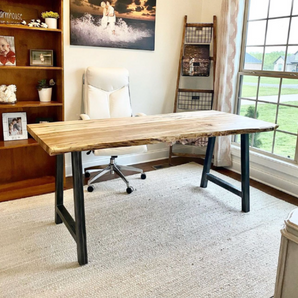Top Trends in Dining Room Table Legs to Elevate Your Dining Space
Top Trends in Dining Room Table Legs to Elevate Your Dining Space
Blog Article
A Thorough Look at Eating Table Leg Styles: Locating the Ideal Suit
Selecting the appropriate table leg style is essential for both aesthetic charm and useful functionality. Traditional 4 legs provide timeless style and security, while the pedestal base provides raised legroom and a contemporary look. For those with bigger tables, trestle legs guarantee durable assistance, whereas hairpin legs introduce a mid-century contemporary vibe with their minimal style. The x-shaped legs blend modern design with enhanced security. Each of these options brings one-of-a-kind benefits, making the choice more than simply a matter of choice. Explore even more to discover which design perfectly matches your dining area and lifestyle.
Typical 4 Legs
Among the various kinds of eating table leg designs, the standard four-leg design continues to be an ageless option for numerous homes. Four legs give balanced support, making sure the table stays steady and capable of birthing significant weight (dining room table legs).
From an aesthetic perspective, the traditional four-leg layout can be conveniently adapted to various indoor styles. Whether crafted from timber, metal, or a combination of products, these legs can be intricately carved, streamlined and minimalistic, or anything in between. Their convenience enables them to match both rustic and contemporary setups effortlessly.
Furthermore, the uncomplicated structure of the four-leg design facilitates convenience of motion and placement within an area. Unlike more complicated bases, this design lessens obstructions, giving adequate legroom for restaurants. In recap, the standard four-leg dining table leg design marries sustaining style with practical performance, making it an astute choice for those looking for both form and feature in their dining furniture.
Pedestal Base
Typically commemorated for its sophisticated and space-efficient design, the pedestal base is a distinguished choice to the typical four-leg setup in table leg styles. This unique base usually includes a single main column sustaining the tabletop, which can differ in form, from ornately sculpted timber to sleek, contemporary steel. One of the main benefits of the pedestal base is its capability to take full advantage of legroom and seating flexibility. Without corner legs, restaurants are managed higher liberty of motion, making it an excellent choice for round and oval tables that advertise even more intimate and comprehensive gatherings.
The main column itself supplies a canvas for detailed styles and artistic expressions, including an aspect of visual passion below the table. In recap, the stand base incorporates capability with design, making it a refined and useful alternative for varied dining settings.
Trestle Legs
Trestle legs offer a durable and ageless structure for dining tables, characterized by their straight cross-bracing and durable assistance beams. Originating see post from middle ages times, this design has actually developed yet preserved its necessary structure, making it a perennial fave in both conventional and modern settings. The main trestle beam, commonly sustained by two or even more vertical articles, offers phenomenal stability, permitting larger table sizes without the need for extra legs.
A substantial advantage of trestle leg tables is the adequate legroom they offer. Unlike tables with 4 edge legs, the absence of blockages at the table's sides offers unblocked room for chairs and restaurants, enhancing comfort and access. This makes trestle tables perfect for suiting bigger events, whether in a dining-room or a banquet hall.
The visual convenience of trestle legs is noteworthy. Offered in a range of products such as wood, metal, and composite, they can be completed to enhance a variety of interior designs. From rustic farmhouse to streamlined modern designs, trestle legs can be customized to fit private preferences. Their long-lasting charm and practical benefits make trestle legs a compelling option for those looking for both design and usefulness in their table.
Barrette Legs

The appeal of barrette legs hinges on their simplicity and flexibility - dining room table legs. Available in a variety of products, including steel and brass, they can be completed in many shades to complement different indoor styles. Whether matched with a rustic wood table top or a modern glass surface, hairpin legs effortlessly mix functionality with a touch of vintage appeal
Resilience is one more significant attribute of barrette legs. Despite their fragile appearance, these legs are crafted to bear considerable weight, making certain the eating table stays secure and secure. Furthermore, they are fairly simple to mount, making them a preferred choice for DIY enthusiasts and professional furniture makers alike.
X-Shaped Legs

Created from materials such as steel, wood, or a mix of both, X-shaped legs can be customized to match numerous style choices. Steel legs typically offer a streamlined and industrial feeling, perfect for loft-style houses and contemporary eating spaces. On the other hand, wood X-shaped legs use a warmer, much more rustic charm, appropriate for farmhouse or eclectic interiors. The flexibility in products permits property owners to customize their eating tables to much better fit their total style scheme.
Moreover, the design behind X-shaped legs makes sure also weight distribution, minimizing the danger of wobbling and boosting toughness. This makes them especially fit for larger table that require extra support. Basically, X-shaped legs blend sensible engineering with modern visual appeals, making them an ageless selection for diverse eating atmospheres.
Verdict
A comprehensive understanding of dining table leg designs exposes the distinctive qualities and advantages of each style. Typical 4 legs supply security and timeless charm, while stand bases offer legroom and a streamlined appearance. Trestle legs ensure robust support for bigger tables, and barrette legs introduce a mid-century modern visual. X-shaped legs incorporate modern layout with improved stability. Choosing the appropriate leg design makes sure both practical and aesthetic fulfillment in any type of eating room.
Report this page